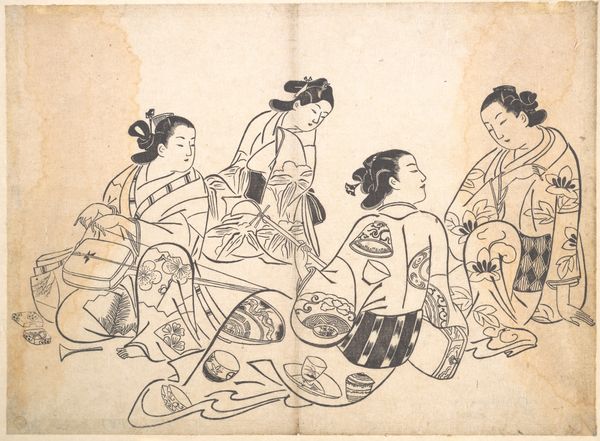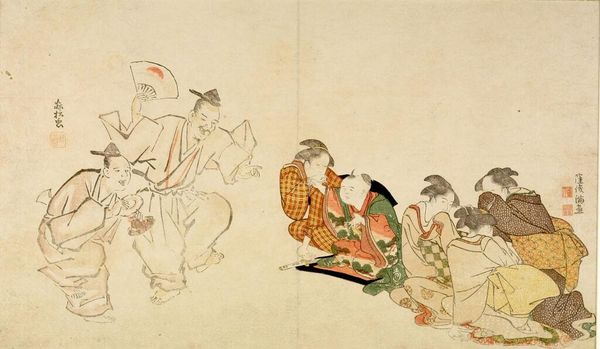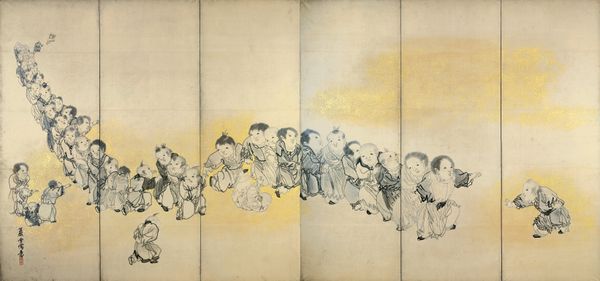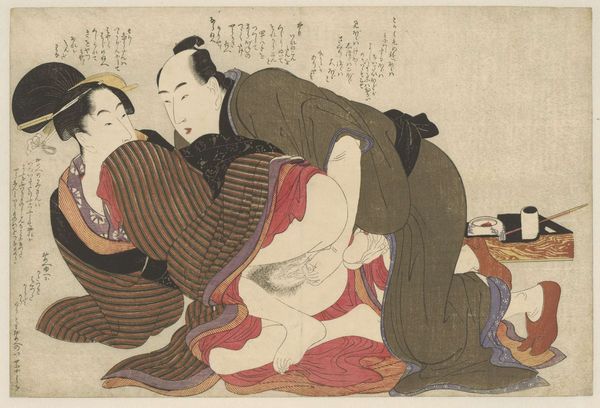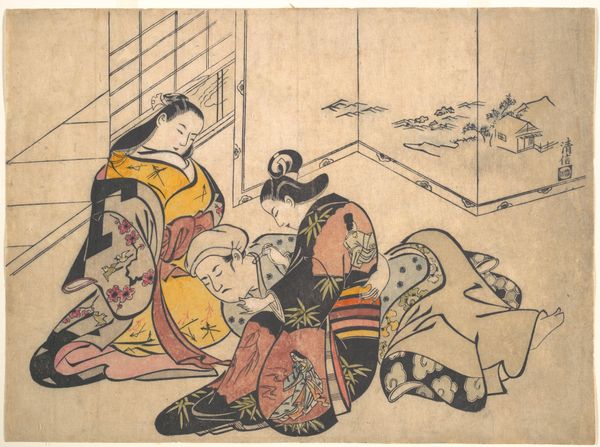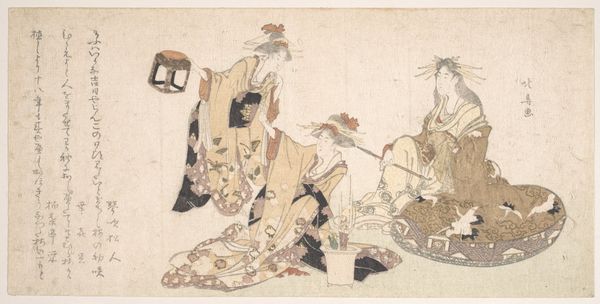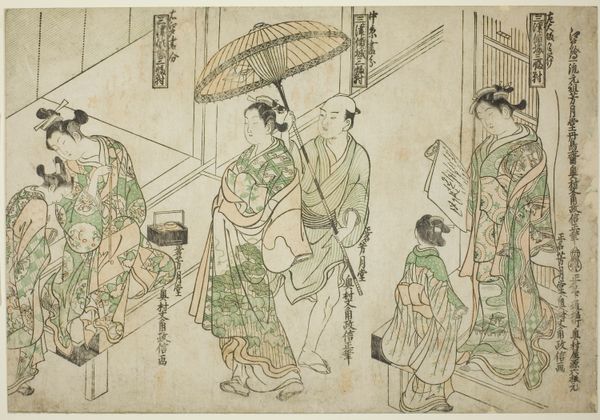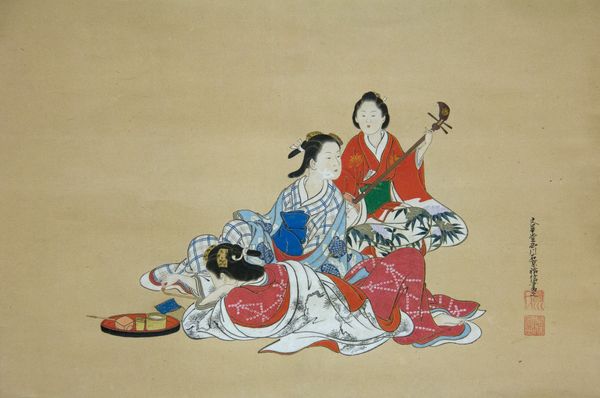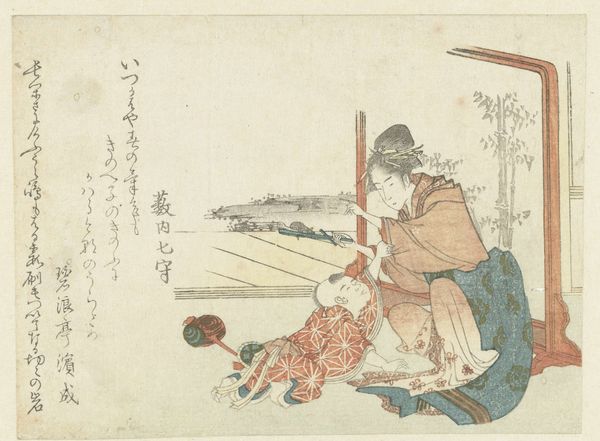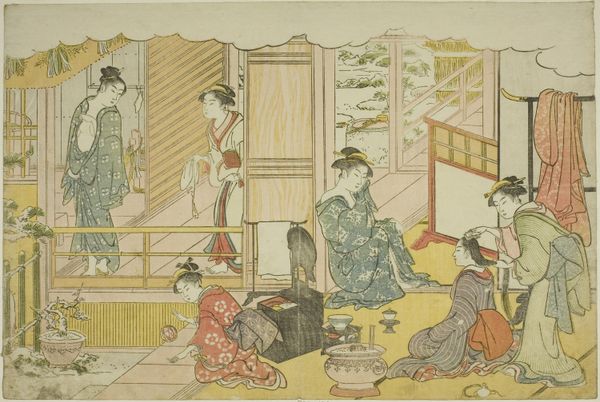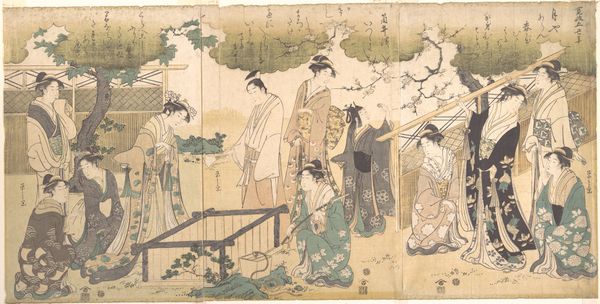
Dimensions: 13 7/16 × 32 1/2 in. (34.13 × 82.55 cm) (image)56 7/16 × 38 1/16 in. (143.35 × 96.68 cm) (mount, without roller)
Copyright: Public Domain
Curator: Before us is "Seven Otafukus," a color-on-silk hanging scroll, estimated to have been created sometime in the 1870s or 1880s, by Kawanabe Kyōsai. Editor: What a playful composition! I’m immediately struck by the clustering of these figures—their expressiveness, too. The colors are quite subdued, but the energy feels rather lively. Curator: Kyōsai was indeed a master of capturing movement and expression. This piece is an excellent example of Ukiyo-e, or "pictures of the floating world," showcasing genre painting focused on daily life, here featuring Otafuku, a Japanese goddess and folk character, also known as Okame. Editor: Okame… Interesting. She’s often associated with mirth, good fortune, and domestic harmony. And here we see not one, but seven! They seem to be engaged in some sort of domestic activity, perhaps a game or craft, if I judge by all the fans. The artist seems more intent on showing types rather than giving personality. Note how they're arranged: their postures suggest activity while at the same time being carefully organized for compositional harmony. Curator: Yes, and it's also worth noting that Kyōsai worked during a period of significant social change in Japan, the Meiji Restoration, when Western influences were rapidly transforming Japanese society. Though he adopted some Western techniques, like perspective, he remained firmly rooted in traditional Japanese artistic styles and themes. Editor: His choice of Okame, then, speaks to that continuity, holding onto deeply ingrained cultural archetypes at a time of disruption and reinvention. It is about humor and hope amid an era of transition. Her ample face and figure represent abundance and generosity—a grounding force. Curator: And the fact that it’s rendered as a hanging scroll also reinforces the connection to older traditions, acting as a reminder of established values. The Otafuku, in their charming simplicity, serve to remind us of simpler joys and enduring Japanese identity. Editor: For me, the enduring appeal lies in the symbolic potency and pure expressive fun in what may initially read as just a folk scene. There's more beneath the surface. Curator: I agree, it's in the artist's grounding himself in cultural tradition as much as with its visual appeal and his mastery with watercolor. A historical narrative is painted into it all the same.
Comments
minneapolisinstituteofart about 2 years ago
⋮
Kawanabe Kyōsai was one of the most versatile and talented artists in the late nineteenth century. Born in 1831 in Koga, Kyōsai first became a pupil of the ukiyo-e artist Utagawa Kuniyoshi (1796-1861) at the age of six. After ten years with Kuniyoshi, he moved on to study the orthodox style of the Kanō school. In 1852, he left the Kanō school and spent the rest of his life as an independent artist. Living in the age of upheaval from the Tokugawa shogunate to the Meiji government, he worked beyond the boundaries of the established schools of painting. Kyōsai exhibited his genius in the wide range of subjects and style of painting as well as printmaking. With his technical refinement, Kyōsai particularly showed tremendous talent in satirical parodies of fantasic and weird subjects with wit and vitality. With a sketchy manner, Kyōsai depicted the lively party of Seven Otafuku playing go (Chinese chess) and calligraphy, two of the four gentlemanly accomplishments of a Chinese literati. In genre painting and ukiyo-e, gentlemen’s sophisticated activities were transformed into a pastime of beautiful courtesans at the pleasure quarters. Here, it is further changed into a raucous entertainment for a cohort of boorish townswomen. The chubby and homely aunts enjoying the women-only party provide a cheerful and jolly mood. These seven Otafuku-faced women are also a parody of the seven gods of good fortune, which bring goodwill and vital energy. This multiple play of themes shows Kyōsai’s creative approach to injecting new twists on a conventional subject.
Join the conversation
Join millions of artists and users on Artera today and experience the ultimate creative platform.
